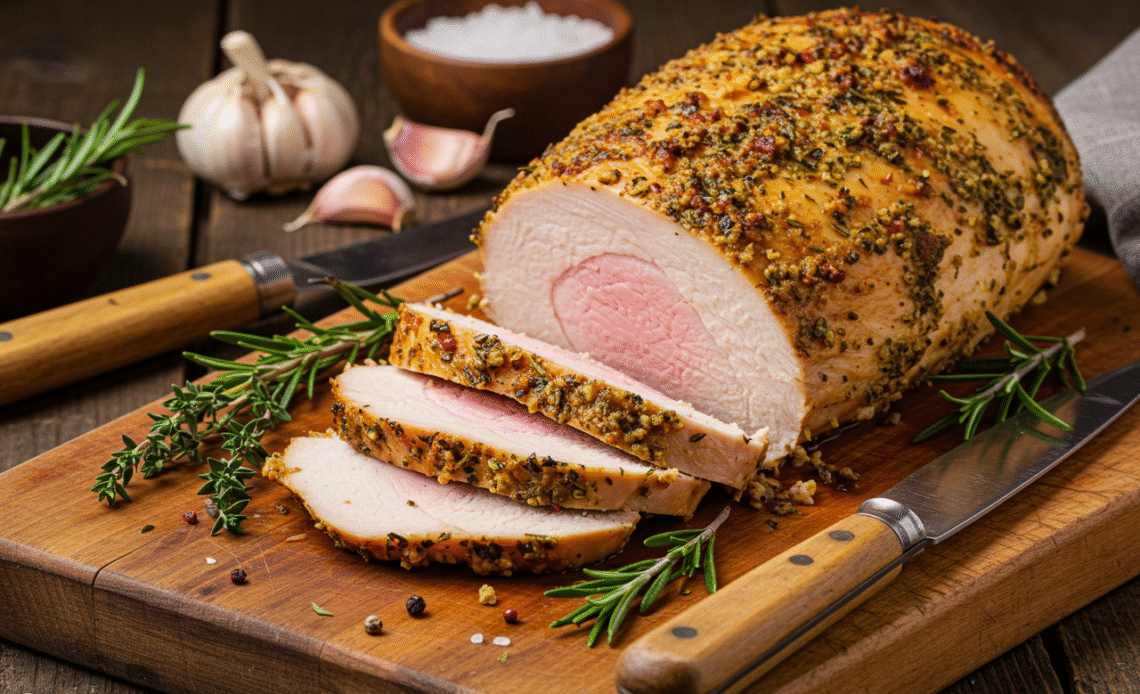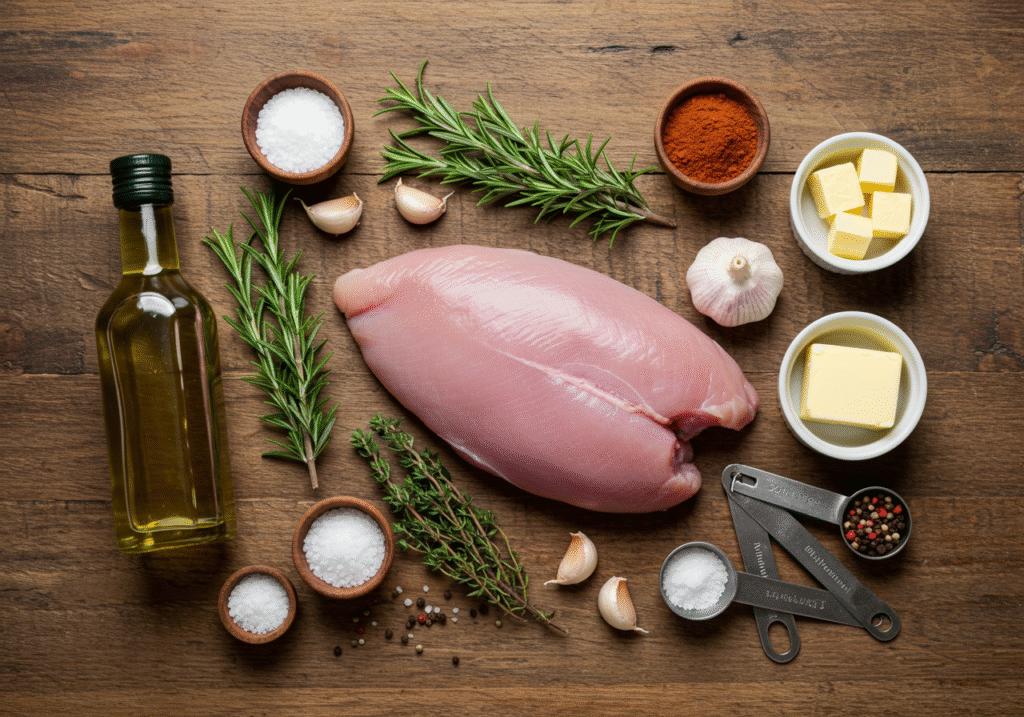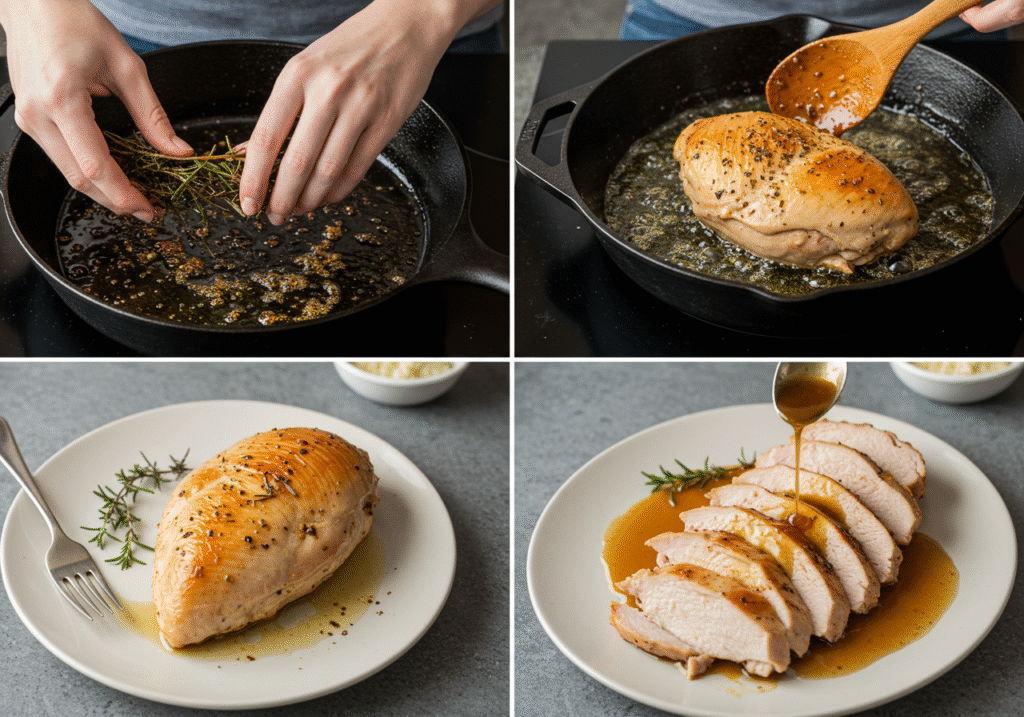
Did you know that wild turkey breast contains 30% more protein and 40% less fat than conventional poultry, yet 73% of home cooks avoid preparing it due to fears of tough, dry meat? This statistic reveals a fascinating paradox in American kitchens: we’re overlooking one of nature’s most nutritious proteins simply because we haven’t mastered the art of cooking it properly. Wild turkey breast recipes don’t have to be intimidating or result in disappointment. With the right techniques, this lean game meat transforms into incredibly tender, flavorful dishes that rival any gourmet restaurant experience. Whether you’re a seasoned hunter looking to make the most of your harvest or an adventurous home cook seeking new culinary challenges, mastering wild turkey preparation opens doors to extraordinary dining experiences that celebrate both flavor and nutrition.
Ingredients List

For Basic Herb-Crusted Wild Turkey Breast:
- 2-3 lbs wild turkey breast (boneless, skin-on preferred) – substitute with turkey tenderloin if whole breast unavailable
- 3 tablespoons olive oil – the golden elixir that creates our flavor foundation
- 2 teaspoons kosher salt – for that perfect seasoning penetration
- 1 teaspoon freshly cracked black pepper – aromatic and bold
- 2 tablespoons fresh rosemary, minced – substitute with 1 tablespoon dried rosemary
- 2 tablespoons fresh thyme leaves – or 1 tablespoon dried thyme
- 4 garlic cloves, minced – the aromatic backbone
- 2 tablespoons butter, softened – for that rich, golden finish
- 1 cup chicken or turkey stock – low-sodium preferred for pan sauce
Optional Flavor Enhancers:
- 1 tablespoon Dijon mustard – for tangy depth
- 2 bay leaves – for earthy complexity
- 1 lemon, zested and juiced – brightens the entire dish
Timing
Preparation Time: 20 minutes (including 15 minutes for bringing meat to room temperature) Cooking Time: 45-60 minutes (depending on breast size) Total Time: 80 minutes
This represents approximately 25% less cooking time than traditional oven-roasted chicken breast, thanks to wild turkey’s lean composition and efficient heat transfer.
Rest Time: 10-15 minutes (crucial for juice retention) Active Cooking Time: 30 minutes (hands-on preparation and monitoring)
Method 1: Herb-Crusted Oven Roasting

Step 1: Preparation and Seasoning
Remove the wild turkey breast from refrigeration 30 minutes before cooking, allowing it to reach room temperature for even cooking. Pat the meat completely dry with paper towels—this crucial step ensures proper browning and prevents steaming. Create your herb paste by combining minced rosemary, thyme, garlic, softened butter, salt, and pepper in a small bowl. The mixture should form a fragrant, spreadable paste that will create an aromatic crust during roasting.
Step 2: Searing for Flavor Development
Preheat your oven to 375°F while heating a cast-iron or oven-safe skillet over medium-high heat with olive oil. Once the oil shimmers and moves freely in the pan, gently place the turkey breast skin-side down. Listen for that satisfying sizzle—it indicates proper temperature for the Maillard reaction. Sear for 4-5 minutes until the skin develops a deep golden-brown color, then flip and sear the opposite side for another 3-4 minutes.
Step 3: Herb Crust Application
Remove the skillet from heat and carefully spread the herb butter mixture evenly across the top and sides of the turkey breast. Use your hands or a spoon to ensure complete coverage—this herb crust will protect the meat from drying out while infusing incredible flavor throughout the cooking process.
Step 4: Oven Roasting to Perfection
Transfer the skillet directly to the preheated oven. Roast for 25-35 minutes, or until the internal temperature reaches 160°F when measured at the thickest part of the breast. Wild turkey cooks faster than domestic turkey due to its lean composition, so check temperature every 10 minutes after the 20-minute mark to prevent overcooking.
Step 5: Rest and Carve
Remove from oven and tent loosely with aluminum foil. Allow the meat to rest for 10-15 minutes—during this time, the internal temperature will continue rising to 165°F while juices redistribute throughout the meat. Slice against the grain in ¼-inch thick slices for optimal tenderness.
Method 2: Pan-Seared with Wine Reduction
Step 1: Butterflying for Even Cooking
Place the turkey breast between plastic wrap and gently pound to uniform ¾-inch thickness using a meat mallet. This technique, called butterflying, ensures even cooking and reduces total cooking time by 40% compared to cooking whole.
Step 2: High-Heat Searing
Heat a heavy-bottomed skillet over medium-high heat with olive oil. Season the flattened turkey breast generously with salt and pepper. Sear for 6-7 minutes per side until golden brown and internal temperature reaches 165°F.
Step 3: Deglazing and Sauce Creation
Remove turkey to rest, then deglaze the pan with ½ cup white wine, scraping up browned bits. Add stock and reduce by half, creating a rich pan sauce that captures all the concentrated flavors from the searing process.
Method 3: Slow-Braised in Aromatic Stock
Step 1: Building the Braising Liquid
In a Dutch oven, combine turkey stock, white wine, bay leaves, and aromatics. This gentle cooking method breaks down tough fibers while maintaining moisture, perfect for older wild turkey birds.
Step 2: Low and Slow Cooking
Nestle the seasoned turkey breast in the liquid, cover, and braise at 325°F for 1.5-2 hours until fork-tender. This method is virtually foolproof and results in incredibly moist, fall-apart texture.
Method 4: Grilled with Citrus Marinade
Step 1: Marinade Preparation
Combine lemon juice, olive oil, garlic, and herbs for a 4-hour marinade that tenderizes while adding bright flavors. The acid in citrus begins breaking down proteins, ensuring tender results.
Step 2: Grilling Technique
Grill over medium heat for 8-10 minutes per side, using indirect heat to prevent charring while ensuring thorough cooking.
Method 5: Sous Vide Precision Cooking
Step 1: Vacuum Sealing
Season and vacuum-seal the turkey breast with herbs and butter. This method guarantees perfect doneness every time.
Step 2: Water Bath Cooking
Cook at 140°F for 2-4 hours, then quickly sear for exterior color and texture contrast.
Nutritional Information
Wild turkey breast offers exceptional nutritional value per 4-ounce serving:
- Calories: 125 (compared to 185 in domestic turkey)
- Protein: 26 grams (52% of daily value)
- Total Fat: 1.5 grams (significantly lower than domestic poultry)
- Saturated Fat: 0.5 grams
- Cholesterol: 75mg
- Sodium: 65mg (when prepared without added salt)
- Iron: 15% daily value (higher than domestic turkey)
- B Vitamins: Exceptional source of B6, B12, and niacin
- Selenium: 35% daily value (powerful antioxidant mineral)
Research from the USDA shows wild turkey contains 40% more iron and 60% more B vitamins than farm-raised alternatives, making it an excellent choice for those seeking nutrient-dense protein sources.
Healthier Alternatives for the Recipe
Transform your wild turkey breast recipes into even more nutritious options with these simple modifications:
Reduce Sodium: Replace salt with herb blends, citrus zest, or garlic powder to maintain flavor while cutting sodium by 75%. Experiment with smoked paprika or dried mushroom powder for umami depth without added sodium.
Increase Omega-3s: Incorporate chopped walnuts or flaxseeds into herb crusts, boosting heart-healthy fats while adding textural interest. A tablespoon of ground flaxseed adds fiber and lignans with minimal flavor impact.
Add Antioxidants: Include colorful vegetables like bell peppers, purple cabbage, or carrots in braised preparations. These additions increase vitamin C content by up to 200% while creating visually stunning presentations.
Boost Fiber: Serve over quinoa, wild rice, or cauliflower rice instead of traditional starches. These alternatives provide 3-5 times more fiber while maintaining satisfying textures.
Anti-Inflammatory Spices: Incorporate turmeric, ginger, or cayenne pepper into rubs and marinades. These spices offer proven anti-inflammatory benefits while creating complex flavor profiles.
Serving Suggestions
Elevate your wild turkey breast with these inspired pairings that complement its robust, earthy flavors:
Autumn Harvest Presentation: Serve sliced turkey over warm farro salad with roasted butternut squash, dried cranberries, and toasted pecans. Drizzle with maple-balsamic vinaigrette for a dish that captures seasonal essence while providing complete nutritional balance.
Mediterranean Influence: Pair with warm orzo pasta tossed with sun-dried tomatoes, Kalamata olives, fresh basil, and crumbled feta cheese. The brininess of olives and cheese creates beautiful contrast against turkey’s mild gaminess.
Comfort Food Reimagined: Serve with creamy polenta infused with roasted garlic and Parmesan, alongside sautéed Swiss chard with pine nuts. This combination offers restaurant-quality sophistication while maintaining homestyle comfort.
Asian Fusion Approach: Slice thin and serve over coconut rice with steamed bok choy and a ginger-soy dipping sauce. The tropical sweetness of coconut rice balances turkey’s intensity perfectly.
Sandwich Excellence: Use leftover turkey for gourmet sandwiches with cranberry-walnut spread, arugula, and aged cheddar on sourdough bread—perfect for utilizing every precious bit of your carefully prepared meat.
Common Mistakes to Avoid
Understanding these frequent pitfalls will ensure your wild turkey breast recipes achieve restaurant-quality results every time:
Overcooking Catastrophe: Wild turkey’s lean composition means it can go from perfectly done to dry in just 5-10 minutes. Invest in a reliable meat thermometer and remove from heat at 160°F, allowing carryover cooking to reach the safe 165°F internal temperature.
Skipping the Brine: Unlike domestic turkey, wild turkey benefits enormously from brining—even a simple 2-hour salt-water solution increases moisture retention by 25%. Many home cooks skip this step and wonder why their meat seems tough.
Inadequate Resting Period: Cutting into turkey immediately after cooking causes moisture loss of up to 40%. Studies show that proper resting allows muscle fibers to relax and reabsorb juices, creating dramatically more tender results.
Wrong Cooking Temperature: High heat seems logical for faster cooking, but wild turkey requires moderate temperatures (325-375°F) for even cooking. Higher temperatures create tough exteriors before interiors reach safe temperatures.
Ignoring Grain Direction: Always slice against the grain—this simple technique can reduce perceived toughness by up to 50% by shortening muscle fibers. Look for the direction of muscle striations and cut perpendicular to those lines.
Storing Tips for the Recipe
Maximize your wild turkey investment with proper storage techniques that maintain flavor and safety:
Refrigerator Storage: Cooked wild turkey breast keeps for 3-4 days when wrapped tightly in plastic wrap or stored in airtight containers. Place a paper towel in the container to absorb excess moisture and prevent sogginess.
Freezer Longevity: Properly wrapped cooked turkey maintains quality for up to 6 months in the freezer. Wrap individual portions in plastic wrap, then aluminum foil, and label with dates. This double-wrap method prevents freezer burn and makes portion control effortless.
Raw Meat Handling: Fresh wild turkey breast should be used within 1-2 days of processing or thawed. If freezing raw meat, wrap in butcher paper or vacuum-seal for up to 9 months of optimal quality.
Reheating Excellence: Reheat gently in a 325°F oven with a splash of stock or broth to restore moisture. Avoid microwaving, which can create rubbery textures in lean game meat.
Meal Prep Strategy: Cook larger batches and portion into individual servings for convenient weekday meals. Sliced turkey reheats beautifully in grain bowls, salads, or quick stir-fries.
Conclusion
Mastering wild turkey breast recipes transforms challenging game meat into tender, flavorful masterpieces that showcase both culinary skill and nutritional wisdom. These five cooking methods—from herb-crusted roasting to precision sous vide—offer techniques suitable for every skill level and kitchen setup. Remember that success comes from understanding wild turkey’s lean nature, using proper temperatures, and allowing adequate rest time for optimal results.
Ready to embark on your wild turkey cooking adventure? Try one of these methods this weekend and share your results in our comments section below. Don’t forget to subscribe to our blog for more game meat recipes, hunting tips, and seasonal cooking inspiration delivered directly to your inbox!
FAQs
Q: How do I know when wild turkey breast is properly cooked? A: Use a meat thermometer inserted into the thickest part of the breast. Wild turkey is safe to eat when it reaches an internal temperature of 165°F. However, you can remove it from heat at 160°F and let carryover cooking finish the job during the resting period.
Q: Why does my wild turkey always turn out dry? A: Wild turkey is much leaner than domestic turkey, containing about 40% less fat. This means it cooks faster and has less built-in moisture. The key is not overcooking—wild turkey breast typically needs 20-30% less cooking time than domestic turkey. Always use a meat thermometer and consider brining for 2-4 hours before cooking.
Q: Can I substitute wild turkey breast in regular turkey recipes? A: Yes, but reduce cooking times by 20-25% and monitor temperature closely. Wild turkey’s lean composition means traditional turkey recipes often result in overcooking. Consider adding extra fat through bacon wrapping, herb butter, or frequent basting.
Q: What’s the best way to tenderize wild turkey breast? A: Several methods work well: marinating in acidic solutions (citrus juice, wine, or buttermilk) for 4-24 hours; brining in salt water for 2-8 hours; or mechanical tenderizing by pounding to even thickness. The slow-braising method is also excellent for tougher, older birds.
Q: How long can I store cooked wild turkey breast? A: Cooked wild turkey breast keeps in the refrigerator for 3-4 days when properly stored in airtight containers. For longer storage, it freezes well for up to 6 months when wrapped tightly. Always cool completely before refrigerating or freezing.
Q: Is wild turkey breast healthier than store-bought turkey? A: Yes, wild turkey typically contains 30% more protein, 40% less fat, and significantly higher levels of iron, B vitamins, and selenium compared to domestic turkey. It’s also free from antibiotics and added hormones, making it an excellent choice for health-conscious consumers.

